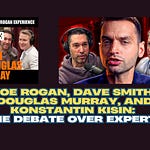The U.S. House Committee on the Weaponization of the Federal Government.
Shellenberger’s testimony outlines a network of government agencies, NGOs, and academic institutions involved in what he terms the "censorship industrial complex." This network allegedly operates to control and suppress various information, particularly on contentious topics like COVID-19 origins, vaccine information, and political issues, by collaborating with social media companies to monitor, label, or remove certain content.
The testimony covers the following key points:
1. **Historical Context**: It begins with President Eisenhower's warning about a "military-industrial complex," comparing it to today’s “censorship-industrial complex,” which Shellenberger argues similarly threatens democratic freedoms.
2. **Network of Institutions and Funding**: The testimony details how institutions like the National Science Foundation and DARPA have funded programs to monitor and counter online disinformation, with prominent involvement from organizations like Stanford Internet Observatory, the Atlantic Council, and Graphika, alongside private entities like Moonshot CVE.
3. **Disinformation Campaigns**: It highlights several instances considered disinformation campaigns, such as:
- The Trump-Russia collusion theory, which Shellenberger argues was exaggerated.
- The COVID-19 lab-leak theory, initially labeled a conspiracy theory despite scientific backing.
- The Hunter Biden laptop story, allegedly downplayed by government influence over social media platforms.
4. **Ideological and Strategic Goals**: According to Shellenberger, the complex’s goal is to create a controlled information environment, increasingly extending censorship to domestic content by labeling it as “misinformation” or “disinformation.” He critiques the ideological foundation of this network as inherently elitist, assuming a small group of experts can determine “truth” for the broader public.
5. **Recommendations**: Shellenberger urges Congress to defund this network, increase transparency of communications between government and social media companies, and reconsider Section 230 protections, which shield platforms from liability for user-generated content.
This testimony argues that these censorship practices go beyond defending democracy and veer into stifling legitimate democratic debate by curtailing free expression, presenting an ideological and operational expansion of censorship by the U.S. government through public-private partnerships.
Michael Shellenberger’s testimony to Congress, now known as "The Censorship Industrial Complex," has spotlighted a network of government agencies, private firms, NGOs, and academic institutions that he claims are actively engaged in coordinated efforts to monitor, influence, and suppress content deemed problematic or disfavored by these institutions. According to Shellenberger, these organizations often operate under the premise of preventing misinformation but actually end up silencing legitimate discourse on complex and often controversial subjects, ranging from public health issues to political debates. He highlights that these entities receive considerable funding from the government, notably from bodies like the National Science Foundation and DARPA, which initially developed techniques for combatting foreign threats but now allegedly apply them domestically to influence public opinion.
At the core of Shellenberger’s argument is the assertion that this "censorship industrial complex" systematically intervenes in public discourse. She claims that agencies, including the Department of Homeland Security’s Cybersecurity and Infrastructure Security Agency (CISA), collaborate closely with social media platforms like Facebook and Twitter to suppress or flag content, particularly around elections and public health topics. For instance, during the 2020 elections, CISA and affiliated entities like the Election Integrity Partnership (EIP) flagged millions of social media posts for moderation or removal, categorizing them as misinformation or potentially harmful narratives. Shellenberger argues that, under this structure, these platforms are effectively pressured into censorship under the guise of maintaining order and integrity online.
Shellenberger and his allies, including journalist Matt Taibbi, argue that this system exceeds mere guidance, as it involves direct influence on social media executives to remove or downrank content that challenges prevailing narratives. For instance, Shellenberger claims that agencies indirectly encourage compliance by holding the possibility of regulatory backlash over social media companies, positioning cooperation as a means to avoid such consequences. In a recent example involving the COVID-19 pandemic, internal emails reportedly show that Facebook faced pressures to moderate content related to vaccine information under threat of adverse policy changes affecting its operations in Europe. This, Shellenberger asserts, led to the removal of even “often-true” information that was deemed problematic due to potential effects on public sentiment.
Shellenberger calls for Congress to defund these activities, promote transparency regarding government-platform interactions, and limit Section 230 protections that currently allow tech companies significant latitude in moderating content. By highlighting these findings, Shellenberger warns of a growing entrenchment of censorship practices within key institutions, presenting a challenge to free speech under the guise of “protecting democracy” from misinformation—a dynamic, he argues, that ultimately undermines democratic processes by restricting open debate on critical issues.
Disinformation: A Guide to Understanding the Hoax of the Century
Quiz
Instructions: Answer the following questions in 2-3 sentences each.
What is the primary concern raised regarding organizations like the Stanford Internet Observatory and Graphika?
What was the initial purpose of Graphika, and how has its focus shifted?
What constitutional right does the government censorship of political speech violate?
Briefly describe the origins and purpose of CISA.
What is the EI-ISAC, and how is it used for censorship purposes?
How does the concept of “prebunking” relate to censorship?
What are the two criteria that define membership in the American ruling class, as described in the text?
What is the significance of the Steele Dossier in the context of Russiagate?
How did the Obama administration leverage the "Russia hacked the 2016 election" narrative?
According to the text, how has the U.S. government's approach to counterterrorism shifted to target domestic populations?
Quiz Answer Key
The primary concern is their inadequate disclosure of ties to the Department of Defense, the CIA, and other intelligence agencies, raising questions about their involvement in institutionalizing censorship research and advocacy.
Graphika was initially a private network analysis firm focused on identifying foreign influence campaigns, particularly Russian interference in elections. Its focus has shifted to include domestic censorship, targeting political speech and COVID-19 discourse.
Government censorship of political speech violates the First Amendment of the U.S. Constitution, which guarantees freedom of speech and expression.
CISA (Cybersecurity and Infrastructure Security Agency) was established in 2018 as a component of DHS (Department of Homeland Security) to lead cybersecurity and critical infrastructure security programs. However, it has expanded its activities into monitoring and influencing online discourse.
The EI-ISAC (Elections Infrastructure Information Sharing and Analysis Center) is a platform used by state and local election officials to share information with CISA. It has been used to flag and censor online content deemed to be "misinformation," effectively silencing critics and dissenting voices.
“Prebunking” involves presenting preemptive counterarguments or warnings about potential "misinformation" before it is widely circulated. Critics argue this manipulates public perception and limits exposure to alternative viewpoints, amounting to a form of censorship.
The two criteria are: (1) attending an elite university and (2) holding a top position in one or more of the following: a major media company, a prestigious university, a large tech company, a powerful bank, or a prominent foundation.
The Steele Dossier, a collection of unverified reports alleging ties between Trump and Russia, was used as the basis for obtaining a FISA warrant to spy on the Trump campaign, despite its questionable credibility. It played a significant role in fueling the Russiagate narrative.
The Obama administration used the "Russia hacked the 2016 election" narrative to justify expanding surveillance powers, increase censorship efforts, and delegitimize Trump's presidency. This narrative laid the groundwork for the subsequent crackdown on "disinformation."
The tactics and infrastructure developed to combat terrorism abroad, such as surveillance technologies and psychological operations, have been repurposed to target domestic populations deemed to be spreading "misinformation" or holding dissenting views.
Essay Questions
Analyze the evolution of the internet from a tool of individual empowerment to a potential instrument of government control and censorship. Discuss the role of Silicon Valley and the national security apparatus in this transformation.
Discuss the concept of the "censorship industrial complex" as described in the text. What are its key components, and how do they work together to shape online discourse?
Critically evaluate the arguments for and against government intervention in regulating "disinformation" online. What are the potential benefits and risks of such actions?
To what extent is the “war on disinformation” a continuation of the “war on terror”? Explore the parallels between these two campaigns, including their justifications, methods, and potential consequences for civil liberties.
How does the text challenge the conventional narrative surrounding Russiagate? What alternative perspectives are presented, and how do they impact our understanding of the events of the 2016 election and its aftermath?
Glossary of Key Terms
Censorship Industrial Complex: A network of government agencies, private companies, and non-profit organizations working together to control and censor online information.
CISA (Cybersecurity and Infrastructure Security Agency): A federal agency within the Department of Homeland Security responsible for protecting critical infrastructure, including election systems. CISA has expanded its activities to include monitoring and influencing online discourse.
Disinformation: False information spread deliberately to deceive or mislead.
EI-ISAC (Elections Infrastructure Information Sharing and Analysis Center): A platform used by state and local election officials to share information about potential threats to elections. This platform has been used to flag and censor online content.
FITF (Foreign Influence Task Force): An interagency group within the FBI responsible for countering foreign influence operations, including disinformation campaigns.
GEC (Global Engagement Center): A division of the U.S. State Department tasked with countering foreign propaganda and disinformation.
Graphika: A private network analysis firm initially focused on identifying foreign influence campaigns. Its work has expanded to include domestic censorship efforts.
Misinformation: False or inaccurate information spread unintentionally.
Prebunking: A strategy to preemptively counter potential "misinformation" by providing warnings or alternative narratives before it is widely circulated.
Russiagate: A term referring to the allegations of collusion between the Trump campaign and Russia during the 2016 presidential election.
Stanford Internet Observatory: A research center at Stanford University that studies online abuse, including disinformation and misinformation.















Share this post